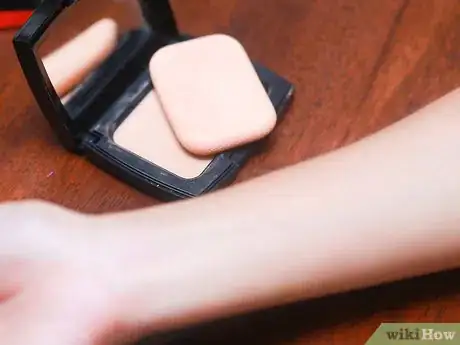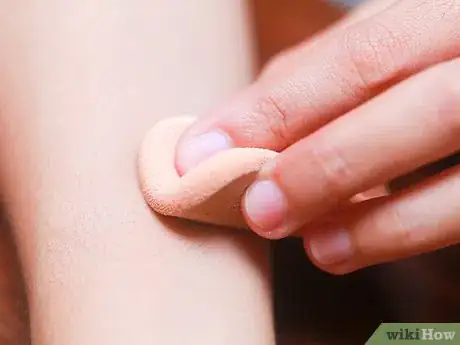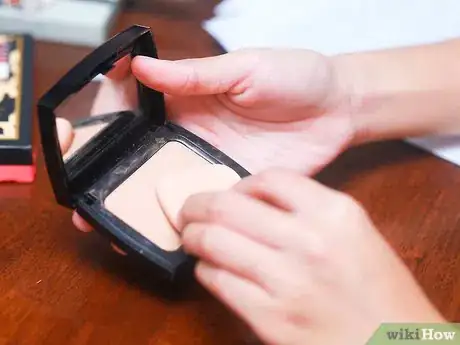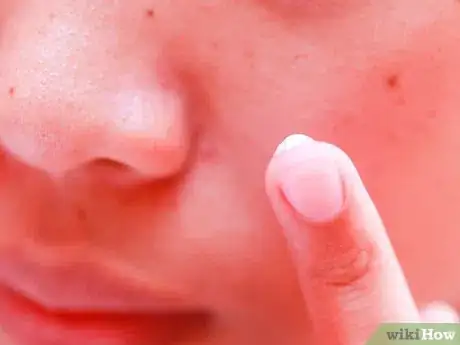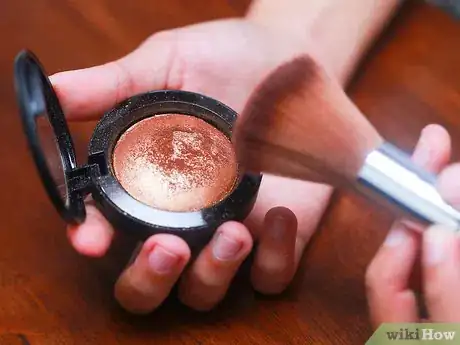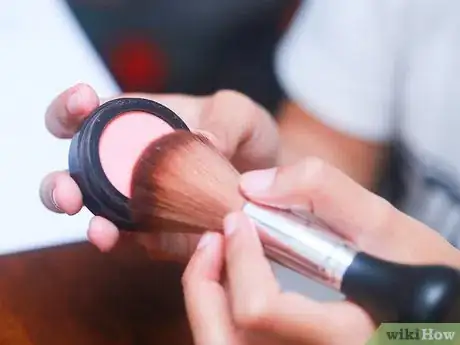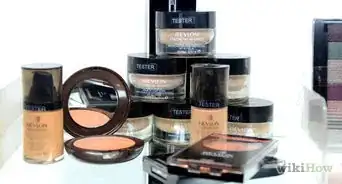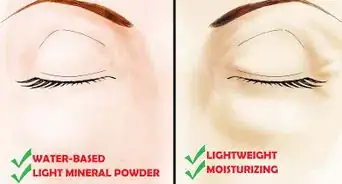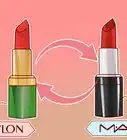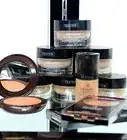This article was co-authored by Daniel Vann. Daniel Vann is the Creative Director for Daredevil Cosmetics, a makeup studio in the Seattle Area. He has been working in the cosmetics industry for over 15 years and is currently a licensed aesthetician and makeup educator.
There are 10 references cited in this article, which can be found at the bottom of the page.
wikiHow marks an article as reader-approved once it receives enough positive feedback. This article received 15 testimonials and 88% of readers who voted found it helpful, earning it our reader-approved status.
This article has been viewed 1,200,545 times.
Foundation is the cosmetic base you use to cover blemishes and even out your complexion so that you have a uniform surface on which to apply the rest of your makeup. It’s important to use the right shade, because the wrong foundation can look obvious and unnatural, and it won’t create the proper canvas for the rest of your cosmetics.There are a few factors to consider when selecting a foundation shade, including skin type, skin tone, and complexion.
Steps
Learning About Your Skin
-
1Understand your undertone. Before trying to choose a foundation, it’s best to determine a few things about your skin, such as your undertone. While the surface of your skin can change color because of many things, such as exposure to the elements or acne, your undertone will always stay the same.[1] Therefore, determining your undertone will help you choose the right foundation color. In general, people fall into one of three undertones:[2]
- Cool, which means your skin is more blue, red, or pink.
- Warm, which means your skin is more golden, yellow, or peach.
- Neutral, which means your skin will have a combination of cool and warm colors.
-
2Determine your undertone. There are a few tests you can use to determine if your undertone is warm, cool, or neutral. The tests involve assessing your hair and eye color, what colors you look best in, how you react to the sun, and the color of your veins.
- Naturally black, brown, or blonde hair combined with green, grey, or blue eyes is an indication of a cool undertone. Hazel, brown, or amber eyes combined with naturally black, auburn, or strawberry blonde hair indicates a warm undertone.[3]
- Silver jewelry will look best on you if your undertone is cool; gold jewelry will look best on you if your undertone is warm; someone with a neutral undertone will look equally good in both silver and gold.[4]
- People who are cool will tend to turn pink or burn easily in the sun, while people who are warm will bronze or tan in the sun.
- Blue veins on the inner wrist indicate cool; green veins indicate warm; bluish-green indicates neutral.[5]
Advertisement -
3Know the best foundation for your skin type. While knowing if you have dry or oily skin won’t help you pick a foundation shade, it will help you choose the right type of foundation. Skin can be oily, dry, or combination, and you can have normal or sensitive skin.
- Choose a matte finish or oil-free liquid or powder foundation if you have oily skin.
- Choose a moisturizing or hydrating cream or stick foundation if you have dry skin.
- Choose a hypoallergenic and scent-free foundation if you have sensitive skin.
- Choose a powder foundation if you have combination skin.[6]
- Choose a foundation that offers full or medium coverage if you have an uneven complexion and want to cover most of your skin. Otherwise, look for a foundation that offers partial or sheer coverage if you have a fairly even complexion and want a more natural look.
- It’s always a good idea to buy foundation that has an SPF, because this will provide a small measure of protection against damaging UVA and UVB rays.
Finding the Perfect Foundation Shade
-
1Use your skin to narrow down your choices. You already know what to look for in a foundation based on your skin type, and now it’s time to use the knowledge you’ve gained about your undertone to select some possible shade choices. Before heading to the pharmacy or makeup store, consider what foundation bases and shades will look best based on your undertone.
- For cool undertones: choose a foundation with a rose, red, or blue base, and consider shades like cocoa, rose, sable, and porcelain.
- For warm undertones: choose a foundation with a gold or yellow base, and consider shades like caramel, golden, tan, chestnut, and beige.
- For neutral undertones: consider shades like buff, nude, ivory, or praline.[7]
-
2Choose a makeup store, pharmacy, or department store. When buying your foundation, look for a store that offers support from beauty experts who can help you choose the right shade and foundation. If that’s not available, look for a shop that has in-store testers so that you can determine the right shade for yourself before you buy. As a last resort, choose a store that has a return policy on cosmetics in case you buy the wrong one.
-
3Test a few shades. Use the information about the best shades for your undertone and select some foundations to try out. Going by eye, choose a few shades that look closest to your skin tone. Then, test them by dabbing some swatches of foundation on your jawline. The skin at your jawline will be truer to your natural undertone and give you an idea of how the foundation will look against your neck.
- If the store doesn’t offer testers, hold the bottles of foundation up to your neck and jawline.
- Whether you are using testers or just holding bottles up to your skin, find a door or window to see what the foundation shades will look like in natural light.[8] This will also give the foundation some time to dry so that you know what it will look like all the time.
-
4Choose your foundation. The best foundation is the one that disappears into your skin. Foundation isn’t supposed to be seen: it’s supposed to provide an even canvas on which to work.[9] Use the swatches on your jawline to determine which foundation blends in best with your skin. This is the foundation shade that will best cover blemishes and redness while still looking natural.[10]
Customizing a Foundation
-
1Lighten foundation that’s too dark. Whether you bought the wrong one and can’t return it or you’re still finishing an older bottle, you can customize the color of your foundation to create a better match for your skin. One way to make foundation lighter is by applying it with a wet sponge instead of your fingers. You can also make foundation lighter by mixing it with:[13]
- Moisturizer
- Primer
- A lighter foundation
- Concealer or finishing powder
-
2Darken foundation that’s too light. Just as you can lighten foundation that’s too dark, so too can you make a foundation darker if it’s too light for your skin. To make foundation darker, try:
- Adding blush or concealer
- Mixing it with bronzer
- Combining it with a darker foundation or tinted moisturizer
-
3Change the color of your foundation. Foundation that isn’t right for your undertone can be customized as well. To make your foundation match a yellow undertone, add turmeric. Add a pinkish-brown blush to match a more pink or blue undertone. [14] To make a foundation more brown, add cocoa powder.
Expert Q&A
-
QuestionWhy does my foundation get cakey?
 Daniel VannDaniel Vann is the Creative Director for Daredevil Cosmetics, a makeup studio in the Seattle Area. He has been working in the cosmetics industry for over 15 years and is currently a licensed aesthetician and makeup educator.
Daniel VannDaniel Vann is the Creative Director for Daredevil Cosmetics, a makeup studio in the Seattle Area. He has been working in the cosmetics industry for over 15 years and is currently a licensed aesthetician and makeup educator.
Licensed Aesthetician You might be packing on the product rather than thinning it out, which causes it to oxidize and bunch up. Using the wrong foundation color could also make your foundation look cakey.
You might be packing on the product rather than thinning it out, which causes it to oxidize and bunch up. Using the wrong foundation color could also make your foundation look cakey. -
QuestionWithout going to the store, how do I find out what skin color I have?
 Community AnswerThere are different websites that will compare a shade of foundation you already own to other shades in different brands. If you don't have any foundation at all, it's usually best to try out the foundation in a store to make sure the shade and the undertone are right for you.
Community AnswerThere are different websites that will compare a shade of foundation you already own to other shades in different brands. If you don't have any foundation at all, it's usually best to try out the foundation in a store to make sure the shade and the undertone are right for you. -
QuestionHow should I choose a highlighter shade?
 Community AnswerUse a highlighter two shades lighter than your natural skin tone.
Community AnswerUse a highlighter two shades lighter than your natural skin tone.
References
- ↑ http://www.paulaschoice.com/expert-advice/makeup-tips/_/makeup-tips-tricks-skin-tone-categories
- ↑ http://www.bustle.com/articles/36375-warm-or-cool-skin-tone-5-questions-to-help-you-determine-your-undertones-so-you-can
- ↑ http://www.bustle.com/articles/36375-warm-or-cool-skin-tone-5-questions-to-help-you-determine-your-undertones-so-you-can
- ↑ https://www.birchbox.com/magazine/article/how-to-match-makeup-undertone
- ↑ http://www.cosmopolitan.com/style-beauty/beauty/advice/g2414/best-foundation-for-your-skin-tone/?slide=2
- ↑ http://www.oprah.com/style/How-to-Choose-and-Use-the-Right-Foundation
- ↑ https://www.birchbox.com/magazine/article/how-to-match-makeup-undertone
- ↑ http://www.fitnessmagazine.com/beauty/makeup/makeup-foundation-tips/?page=4
- ↑ Daniel Vann. Licensed Aesthetician. Expert Interview. 12 April 2019.
- ↑ http://beauty.about.com/od/makeuptrickstips/ht/foundation.htm
- ↑ http://beauty.about.com/od/makeuptrickstips/ht/foundation.htm
- ↑ Daniel Vann. Licensed Aesthetician. Expert Interview. 12 April 2019.
- ↑ http://www.popsugar.com/beauty/How-Fix-Too-Dark-Foundation-Shade-23979084
- ↑ http://classroom.synonym.com/darken-liquid-makeup-12030.html
About This Article
To find the best foundation color shade for you, figure out the undertones of your skin. To do this, look at the veins on your wrist. If they look blue, your skin is cool toned, and if they look green, your skin is warm toned. If your skin is warm toned, look for a gold or yellow based foundation. If your skin is cool toned, find products with pink or blue bases. Regardless of your undertone, test out shades by holding the bottle up your skin and, if the store offers testers, swatch a little foundation on your jawline to find a good match. To learn how to correct makeup that is too light or too dark, keep reading.



